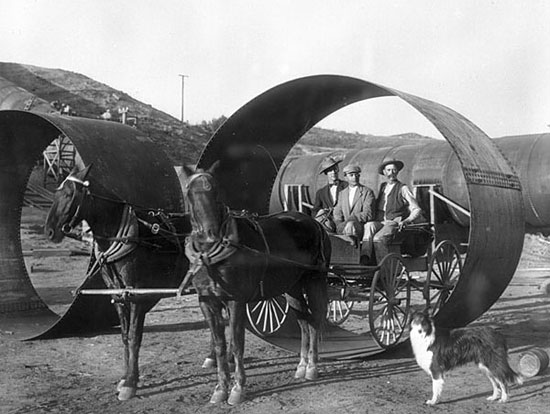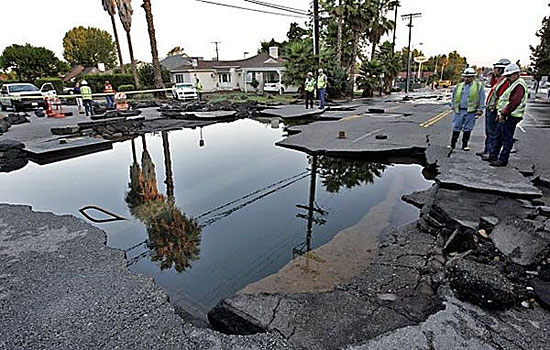Coldwater Canyon’s pipe with a past
March 14, 2013

Undated DWP photo shows pipe used for aqueduct. Smaller pipe of the same riveted steel built the trunk line.
It was 1913 when William Mulholland famously declared, “There it is. Take it.”
But it wasn’t until 1915 that thirsty folks down in the city of Los Angeles could actually take a swig of all that Owens River water pouring into the Los Angeles Aqueduct.
The missing link? The City Trunk Line, known at the time as the “San Fernando Syphon,” an underground water pipe stretching from Sylmar across the Valley (not yet part Los Angeles) through a tunnel in the Santa Monica Mountains to the Franklin Reservoir above Beverly Hills.
With the trunk line’s completion on June 6, 1914, and connecting pipes finished the following year, Mulholland’s aqueduct at last had a direct connection to the city whose growth it would fuel so explosively in the decades to come.
Now, 99 years later, a new generation of Angelenos is feeling its power. And not in a good way.
Commuters on Coldwater Canyon Avenue, a major thoroughfare between the San Fernando Valley and the Westside, recently learned that the street will be closing between Mulholland Drive and Ventura Boulevard for nearly five weeks, from March 23-April 25, so that the city’s Department of Water and Power can replace a 1.3-mile segment of the aging pipe. [Updated 4/24/13: Coldwater Canyon has been reopened, two days ahead of schedule, city officials announced. However, restrictions on left-hand turns are still in place through June 1.)
Clearly, the inconvenience will be sizeable. As Supervisor Zev Yaroslavsky told reporters at a news conference this week announcing the closure: “You can put lipstick on a pig, but it’s still a pig. And this is a pig of a project.”
But he and other local leaders emphasized that the work is important—and unavoidable.
Corroded and susceptible to leaks, a section of the trunk line burst sensationally in 2009, sending millions of gallons of water bursting through the pavement and damaging homes and businesses around Coldwater Canyon and Ventura Boulevard. Earlier, in 2002, the line ruptured in Pacoima after workers inadvertently scraped the pipe, hastening corrosion on that segment to the breaking point.
The Coldwater Canyon closure comes after some 35-45% of the old pipe already has been replaced; modernizing the entire trunk line is expected to take about ten years, said Susan Rowghani, director of the DWP’s water engineering and technical services division.
About 25,000 gallons of water gush through the trunk line on the average each minute. With a diameter ranging from 62 inches to 72 inches in various places, the pipe is smaller than the massive pipes of the aqueduct itself, which range from 84 inches to 120 inches and were photographed at the time of construction with automobiles and even horse-drawn buggies parked comfortably inside. Other than size, though, the pipes used in the aqueduct and trunk line were virtually identical, made of the same riveted steel that was the construction standard at the time, said Fred Barker, manager of water transmission operations at the DWP and the agency’s unofficial historian.
Despite the trunk line’s ripe old age, he said, it’s far from unique in the city’s subterranean water world, where 287 miles of the DWP’s 7,289 miles of pipe date back to 1914 or before.
There’s even a cast iron pipe from the mid-1880s that still runs under 7th Street downtown for six to eight blocks, he said. There are no plans to replace it at the moment. “It’s performing very well,” Barker said. “There’s no need to replace a pipe that doesn’t leak.”
Sadly, the same can’t be said of the venerable City Trunk Line. So it’s with a sense of respect for history that Barker marks its inevitable passing from the scene.
“We talk about this event in 1913, when Mulholland and 40,000 people were out there and the water came down the hill and he said, ‘There it is. Take it.’ But the only way they could take it was in little souvenir bottles…if you wanted that water, you had to go out to Sylmar to get it.
“They had to get it to the city. This is the pipe that did it.”
Now the riveted steel pipe of a century ago is giving way to modern day welded steel—which, Barker said, “is going to last at least as long—and maybe twice as long.”
Posted 3/7/13













 405 bridge work causes a stink
405 bridge work causes a stink

